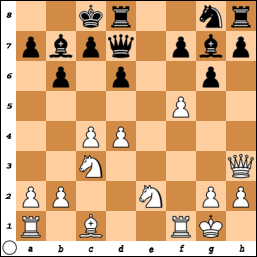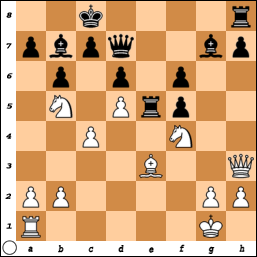It's a bit hard to keep up with posting my games such that there would be at least rudimentary commentary. Right now I just have 30 minutes to write my post before I have to be on the road again. This time, because I want to visit my mother in the hospital before the 7th round starts today at 2 pm. So there'll be one game, only.
Round 3: Uwira, O. (2230) - Schmitzer, K. (2318)
1. d4 e6 2. c4 b6 3. e4 Bb7 4. Bd3 Nc6 Too bad that he didn't try 4...f5 here against which I was armed to the teeth. 5. Ne2 Nb4 6. O-O Maybe 6. Nbc3 would have been more accurate. This would force Black to swap on d3 immediately as White is threatening to preserve the bishop with Bb1. Then I have seen some games where White played an early h2-h4-h5 before castling. That's definitely an idea but I haven't dug into it as of now. 6...g6 7. Nbc3 Nxd3 8. Qxd3 Bg7 9. Qh3!? An over-the-board inspiration. I wanted to prevent the development of the king's knight because it would always allow Bh6 to the benefit of White. The move also lends some support to the advance f4-f5 which now can't easily be blocked by f7-f5. The disadvantage is that the queen is decentralised.9...d6 10. f4 Qd7 11. f5 exf5 12. exf5 O-O-O (Diagram)
 Now it's time to reach a decision. Some of my fellow players claimed that White would have had a huge advantage after 13.d5 but my oppenent had planned 13...Be5 against that and it's not self-evident where the White advantage actually lies. I believe that White probably should move his queen, thus breaking the pin of the pawn f5. An idea would be e.g. 13.Qd3 Nf6 14.Bg5. What I did instead was preparing an ambitious exchange sacrifice, planning to lock the black pieces behind their pawns. 13. Bg5?! f6 14. Be3 Ne7 White could still apply the emergency brake with 15. Ng3 here. But my idea was tempting me too much. 15. d5?! The exclamation mark is only given for the vim to actually push through with the plan. 15...Nxf5 16. Rxf5 In for a penny, in for a pound! 16...gxf5 17. Nf4 Rde8 18. Nb5 Re5! (Diagram)
Now it's time to reach a decision. Some of my fellow players claimed that White would have had a huge advantage after 13.d5 but my oppenent had planned 13...Be5 against that and it's not self-evident where the White advantage actually lies. I believe that White probably should move his queen, thus breaking the pin of the pawn f5. An idea would be e.g. 13.Qd3 Nf6 14.Bg5. What I did instead was preparing an ambitious exchange sacrifice, planning to lock the black pieces behind their pawns. 13. Bg5?! f6 14. Be3 Ne7 White could still apply the emergency brake with 15. Ng3 here. But my idea was tempting me too much. 15. d5?! The exclamation mark is only given for the vim to actually push through with the plan. 15...Nxf5 16. Rxf5 In for a penny, in for a pound! 16...gxf5 17. Nf4 Rde8 18. Nb5 Re5! (Diagram)  Black had sunk into deep thought for half an hour and now presents the refutation of White's sacrifice. Passive moves would have led to the setup that I had envisaged, a.k.a plant a knight into e6, take back the pawn on f5, massage the rest of the pawn weaknesses. The fact that he didn't look too happy while searching for 18...Re5! told me that he probably didn't think that my sacrifice was complete nonsense and that he was well aware of the looming dangers. With the strong text move, Black brings one of his rooks into battle before the door is closed on e6. Moreover, the rook also supports the bind-breaking c7-c6. 19. Nxa7+ Kb8 20. Nb5 Rhe8 21. Bd2 c6 22. Nd4 cxd5 23. cxd5 Bxd5 Too bad, that 24. Nxd5 Rxd5 25. Qb3 is saved by 25...Qb7. Now White can only play on for tricks. 24. Bc3 Bf8 25. a4 Be4 26. Nb5 d5 27. b4 d4 28. Nxd4 Bxb4 29. Nb5 Bxc3 30. Qxc3 Rc8 31. Qb4 Rec5 32. Nd4 Qd6 33. Qd2 Rc2 34. Qe3 R8c3 35. Nb5 Rxe3 36. Nxd6 Rec3 37. g4 Rf3 38. Rf1 Rxf1+ 39. Kxf1 fxg4 40. Nh5 Bd3+ 0-1
Black had sunk into deep thought for half an hour and now presents the refutation of White's sacrifice. Passive moves would have led to the setup that I had envisaged, a.k.a plant a knight into e6, take back the pawn on f5, massage the rest of the pawn weaknesses. The fact that he didn't look too happy while searching for 18...Re5! told me that he probably didn't think that my sacrifice was complete nonsense and that he was well aware of the looming dangers. With the strong text move, Black brings one of his rooks into battle before the door is closed on e6. Moreover, the rook also supports the bind-breaking c7-c6. 19. Nxa7+ Kb8 20. Nb5 Rhe8 21. Bd2 c6 22. Nd4 cxd5 23. cxd5 Bxd5 Too bad, that 24. Nxd5 Rxd5 25. Qb3 is saved by 25...Qb7. Now White can only play on for tricks. 24. Bc3 Bf8 25. a4 Be4 26. Nb5 d5 27. b4 d4 28. Nxd4 Bxb4 29. Nb5 Bxc3 30. Qxc3 Rc8 31. Qb4 Rec5 32. Nd4 Qd6 33. Qd2 Rc2 34. Qe3 R8c3 35. Nb5 Rxe3 36. Nxd6 Rec3 37. g4 Rf3 38. Rf1 Rxf1+ 39. Kxf1 fxg4 40. Nh5 Bd3+ 0-1


Uhi, das ist nun wirklich sprachbegabt, ein blog in englischer Sprache, Respekt!
ReplyDeleteLiebe Grüße aus Bad Vilbel
Katrin
Hyviä analyysejä sinulla !
ReplyDeletePertsa